Abstract
AIMS: To investigate the relation between proliferative activity of anterior pituitary adenomas, quantified by the Ki-67 labelling index, and their invasive behaviour. METHODS: Expression of Ki-67 was evaluated in 103 anterior pituitary adenomas consecutively operated on in a 36 month period and correlated with surgical evidence of invasiveness. RESULTS: Non-invasive (n = 65) and invasive (n = 38) adenomas were identified from surgically verified infiltration of sellar floor dura and bone. The wall of the cavernous sinus was infiltrated in 16 cases. Forty one adenomas were non-functioning and 62 functioning (24 prolactin, 21 growth hormone, 10 ACTH, seven mixed). The overall mean (SD) Ki-67 labelling index was 2.64 (3.69) per cent (median 1.5). The mean index was 3.08 (4.59) per cent in functioning and 1.97 (1.78) per cent in non-functioning tumours; 5.47 (9.52) per cent in ACTH adenomas and 2.33 (2.42) per cent in others (p = 0.01); 3.71 (5.17) per cent in invasive and 2.01 (2.45) per cent in non-invasive adenomas (p = 0.027); and 5.58 (7.24) per cent in cavernous sinus infiltrating v 2.10 (2.39) per cent in cavernous sinus non-infiltrating adenomas (p = 0.0005). To identify a value of labelling index beyond which adenomas should be considered invasive and another beyond which cavernous sinus infiltration should be suspected, normality Q-Q plots were obtained: a threshold labelling index of 3.5% for invasive adenomas and of 5% for cavernous sinus infiltrating adenomas was defined, with statistically significant differences (p = 0.02 and p = 0.004, respectively). CONCLUSIONS: The Ki-67 labelling index can be considered a useful marker in determining the invasive behaviour of anterior pituitary adenomas.
Full text
PDF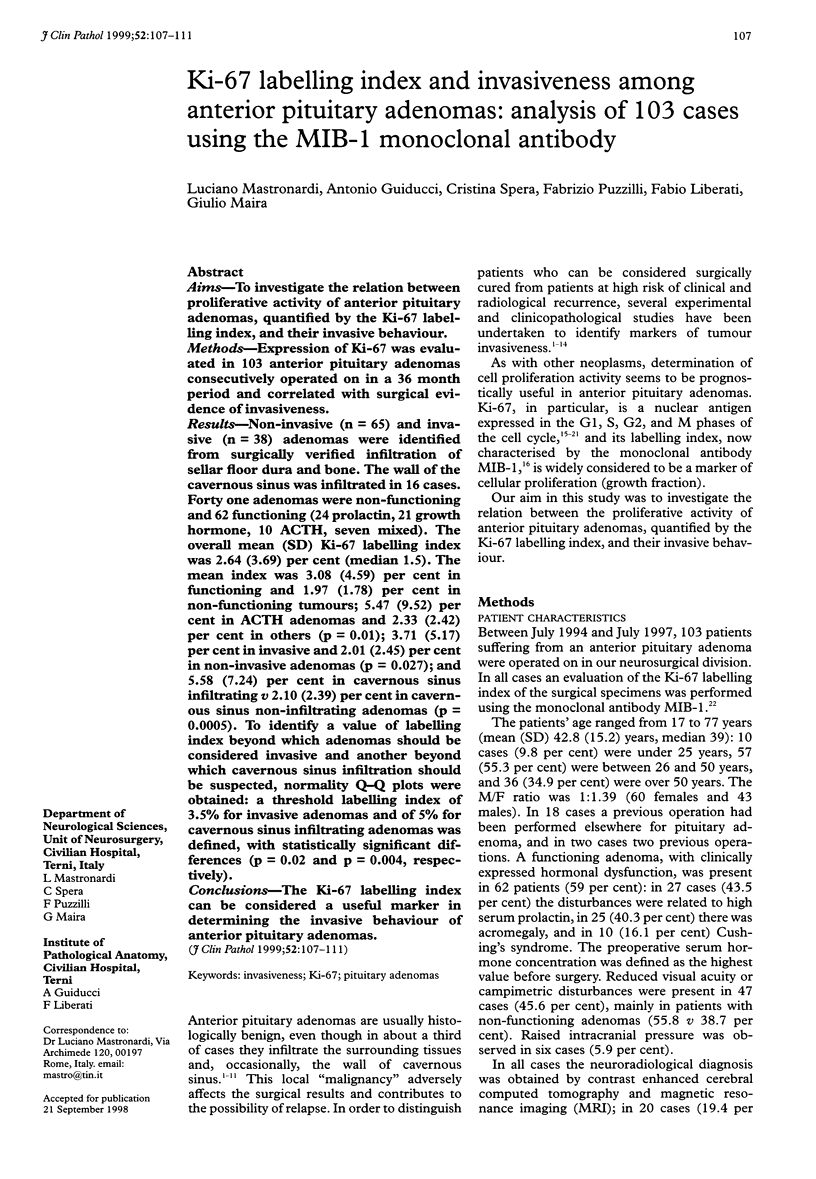
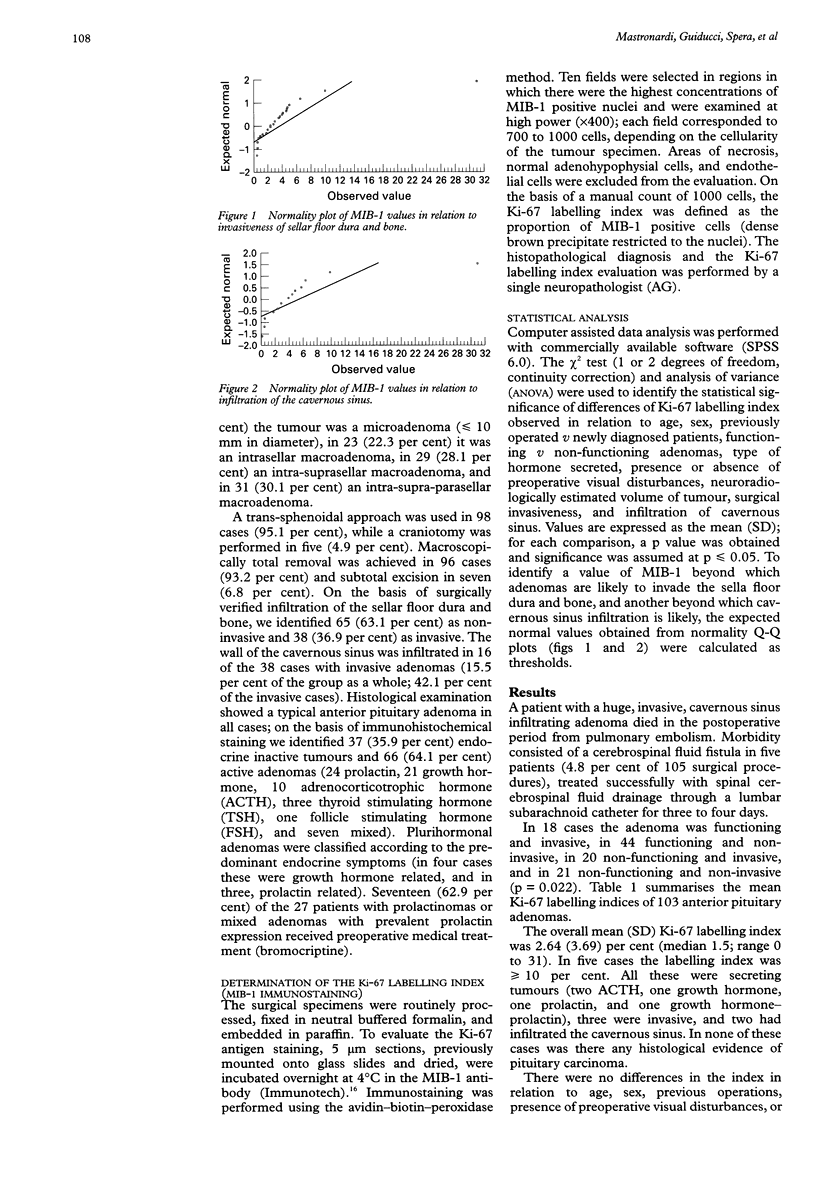
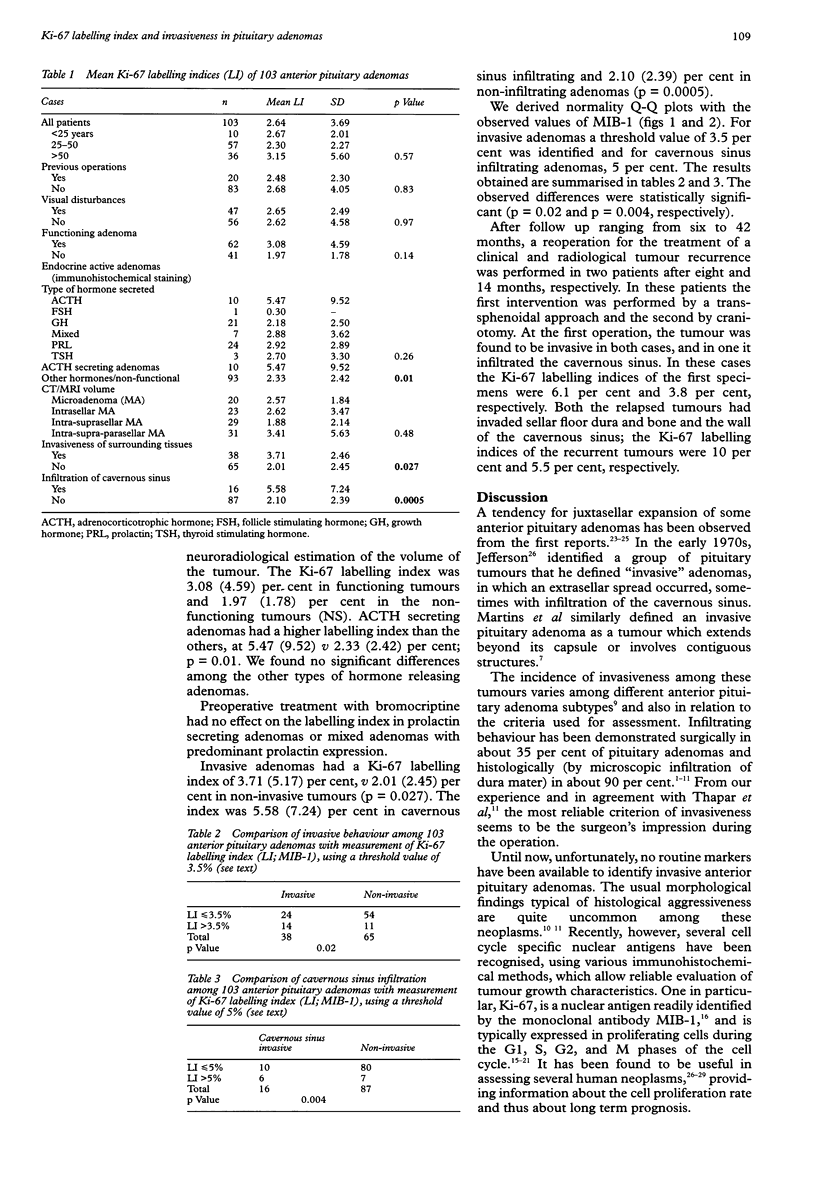
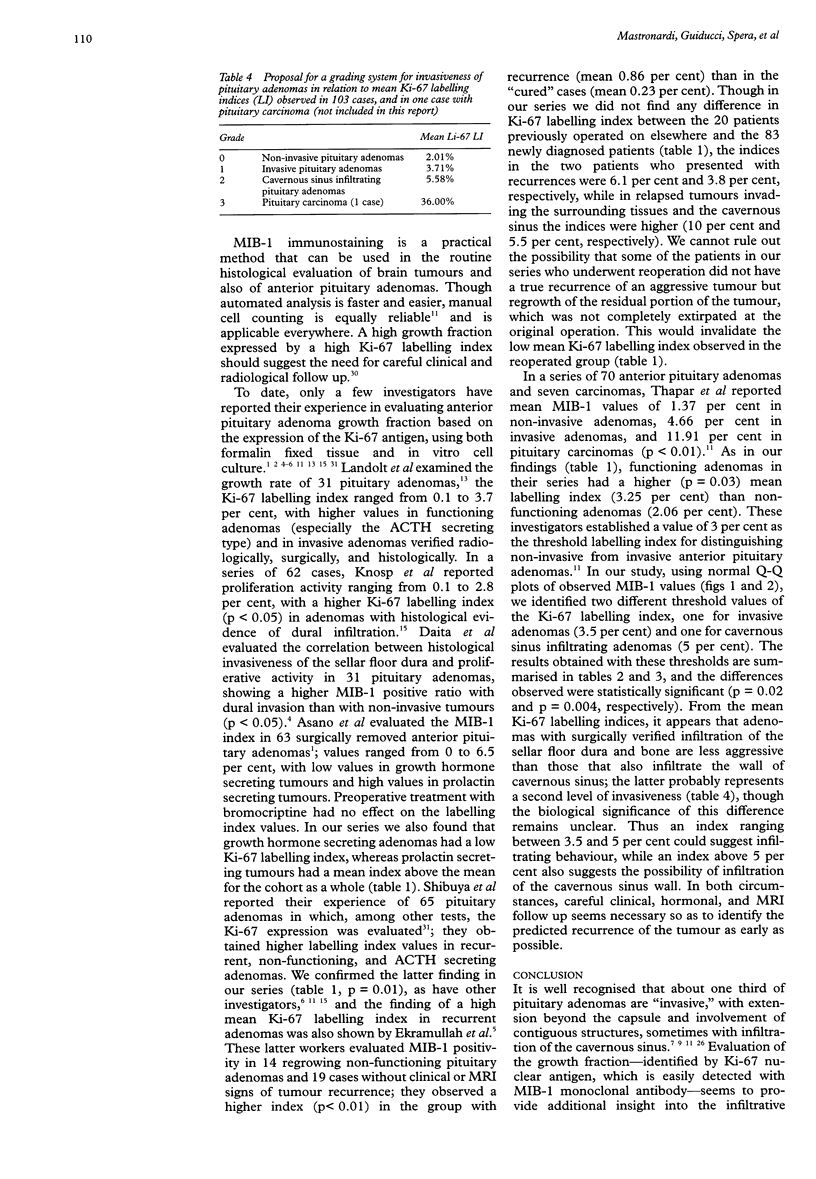
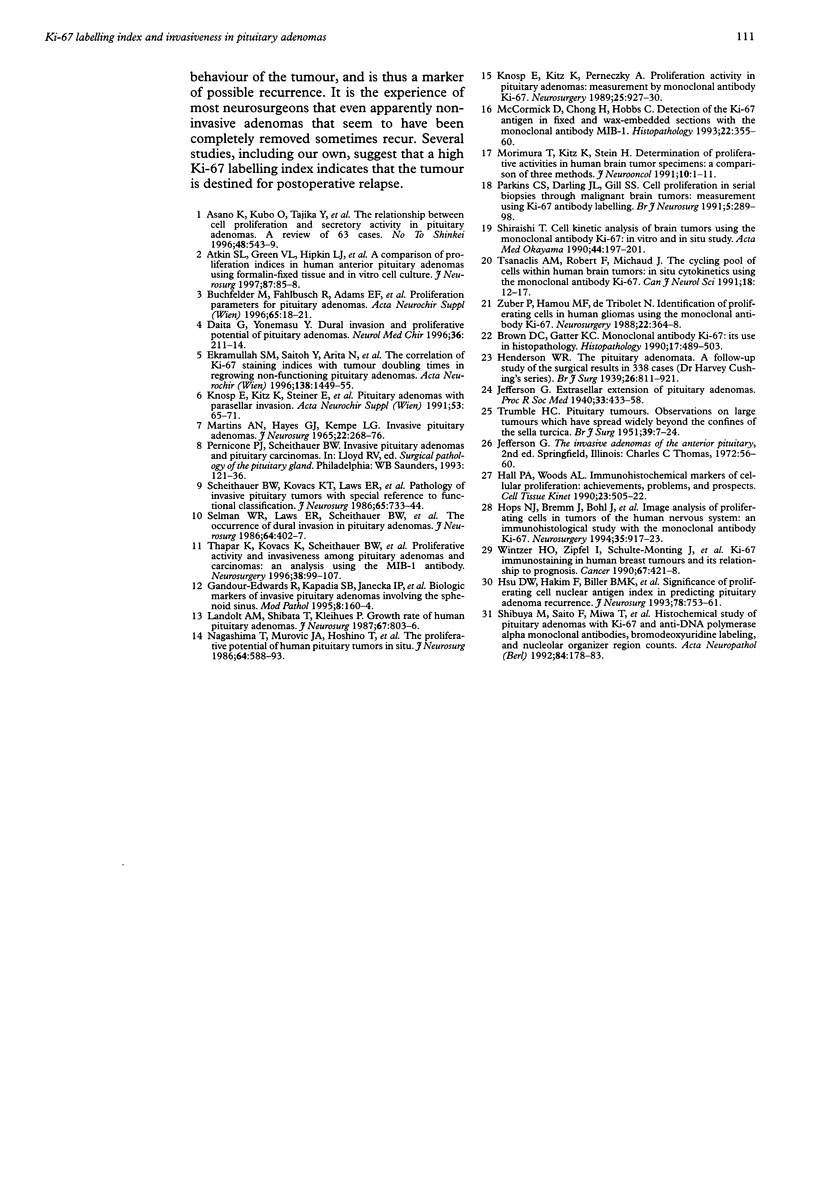
Selected References
These references are in PubMed. This may not be the complete list of references from this article.
- Asano K., Kubo O., Tajika Y., Huang M. C., Takakura K. [The relationship between cell proliferation activity and secretory activity in pituitary adenoma--a review of 63 cases]. No To Shinkei. 1996 Jun;48(6):543–549. [PubMed] [Google Scholar]
- Atkin S. L., Green V. L., Hipkin L. J., Landolt A. M., Foy P. M., Jeffreys R. V., White M. C. A comparison of proliferation indices in human anterior pituitary adenomas using formalin-fixed tissue and in vitro cell culture. J Neurosurg. 1997 Jul;87(1):85–88. doi: 10.3171/jns.1997.87.1.0085. [DOI] [PubMed] [Google Scholar]
- Brown D. C., Gatter K. C. Monoclonal antibody Ki-67: its use in histopathology. Histopathology. 1990 Dec;17(6):489–503. doi: 10.1111/j.1365-2559.1990.tb00788.x. [DOI] [PubMed] [Google Scholar]
- Buchfelder M., Fahlbusch R., Adams E. F., Kiesewetter F., Thierauf P. Proliferation parameters for pituitary adenomas. Acta Neurochir Suppl. 1996;65:18–21. doi: 10.1007/978-3-7091-9450-8_7. [DOI] [PubMed] [Google Scholar]
- Daita G., Yonemasu Y. Dural invasion and proliferative potential of pituitary adenomas. Neurol Med Chir (Tokyo) 1996 Apr;36(4):211–214. doi: 10.2176/nmc.36.211. [DOI] [PubMed] [Google Scholar]
- Ekramullah S. M., Saitoh Y., Arita N., Ohnishi T., Hayakawa T. The correlation of Ki-67 staining indices with tumour doubling times in regrowing non-functioning pituitary adenomas. Acta Neurochir (Wien) 1996;138(12):1449–1455. doi: 10.1007/BF01411125. [DOI] [PubMed] [Google Scholar]
- Gandour-Edwards R., Kapadia S. B., Janecka I. P., Martinez A. J., Barnes L. Biologic markers of invasive pituitary adenomas involving the sphenoid sinus. Mod Pathol. 1995 Feb;8(2):160–164. [PubMed] [Google Scholar]
- Hall P. A., Woods A. L. Immunohistochemical markers of cellular proliferation: achievements, problems and prospects. Cell Tissue Kinet. 1990 Nov;23(6):505–522. doi: 10.1111/j.1365-2184.1990.tb01343.x. [DOI] [PubMed] [Google Scholar]
- Hopf N. J., Bremm J., Bohl J., Perneczky A. Image analysis of proliferating cells in tumors of the human nervous system: an immunohistological study with the monoclonal antibody Ki-67. Neurosurgery. 1994 Nov;35(5):917–923. doi: 10.1227/00006123-199411000-00017. [DOI] [PubMed] [Google Scholar]
- Hsu D. W., Hakim F., Biller B. M., de la Monte S., Zervas N. T., Klibanski A., Hedley-Whyte E. T. Significance of proliferating cell nuclear antigen index in predicting pituitary adenoma recurrence. J Neurosurg. 1993 May;78(5):753–761. doi: 10.3171/jns.1993.78.5.0753. [DOI] [PubMed] [Google Scholar]
- Jefferson G. Extrasellar Extensions of Pituitary Adenomas: (Section of Neurology). Proc R Soc Med. 1940 May;33(7):433–458. [PMC free article] [PubMed] [Google Scholar]
- Knosp E., Kitz K., Perneczky A. Proliferation activity in pituitary adenomas: measurement by monoclonal antibody Ki-67. Neurosurgery. 1989 Dec;25(6):927–930. [PubMed] [Google Scholar]
- Knosp E., Kitz K., Steiner E., Matula C. Pituitary adenomas with parasellar invasion. Acta Neurochir Suppl (Wien) 1991;53:65–71. doi: 10.1007/978-3-7091-9183-5_12. [DOI] [PubMed] [Google Scholar]
- Landolt A. M., Shibata T., Kleihues P. Growth rate of human pituitary adenomas. J Neurosurg. 1987 Dec;67(6):803–806. doi: 10.3171/jns.1987.67.6.0803. [DOI] [PubMed] [Google Scholar]
- MARTINS A. N., HAYES G. J., KEMPE L. G. INVASIVE PITUITARY ADENOMAS. J Neurosurg. 1965 Mar;22:268–276. doi: 10.3171/jns.1965.22.3.0268. [DOI] [PubMed] [Google Scholar]
- McCormick D., Chong H., Hobbs C., Datta C., Hall P. A. Detection of the Ki-67 antigen in fixed and wax-embedded sections with the monoclonal antibody MIB1. Histopathology. 1993 Apr;22(4):355–360. doi: 10.1111/j.1365-2559.1993.tb00135.x. [DOI] [PubMed] [Google Scholar]
- Nagashima T., Murovic J. A., Hoshino T., Wilson C. B., DeArmond S. J. The proliferative potential of human pituitary tumors in situ. J Neurosurg. 1986 Apr;64(4):588–593. doi: 10.3171/jns.1986.64.4.0588. [DOI] [PubMed] [Google Scholar]
- Scheithauer B. W., Kovacs K. T., Laws E. R., Jr, Randall R. V. Pathology of invasive pituitary tumors with special reference to functional classification. J Neurosurg. 1986 Dec;65(6):733–744. doi: 10.3171/jns.1986.65.6.0733. [DOI] [PubMed] [Google Scholar]
- Selman W. R., Laws E. R., Jr, Scheithauer B. W., Carpenter S. M. The occurrence of dural invasion in pituitary adenomas. J Neurosurg. 1986 Mar;64(3):402–407. doi: 10.3171/jns.1986.64.3.0402. [DOI] [PubMed] [Google Scholar]
- Shibuya M., Saito F., Miwa T., Davis R. L., Wilson C. B., Hoshino T. Histochemical study of pituitary adenomas with Ki-67 and anti-DNA polymerase alpha monoclonal antibodies, bromodeoxyuridine labeling, and nucleolar organizer region counts. Acta Neuropathol. 1992;84(2):178–183. doi: 10.1007/BF00311392. [DOI] [PubMed] [Google Scholar]
- TRUMBLE H. C. Pituitary tumours; observations on large tumours which have spread widely beyond the confines of the sella turcica. Br J Surg. 1951 Jul;39(153):7–24. doi: 10.1002/bjs.18003915303. [DOI] [PubMed] [Google Scholar]
- Thapar K., Kovacs K., Scheithauer B. W., Stefaneanu L., Horvath E., Pernicone P. J., Murray D., Laws E. R., Jr Proliferative activity and invasiveness among pituitary adenomas and carcinomas: an analysis using the MIB-1 antibody. Neurosurgery. 1996 Jan;38(1):99–107. doi: 10.1097/00006123-199601000-00024. [DOI] [PubMed] [Google Scholar]
- Wintzer H. O., Zipfel I., Schulte-Mönting J., Hellerich U., von Kleist S. Ki-67 immunostaining in human breast tumors and its relationship to prognosis. Cancer. 1991 Jan 15;67(2):421–428. doi: 10.1002/1097-0142(19910115)67:2<421::aid-cncr2820670217>3.0.co;2-q. [DOI] [PubMed] [Google Scholar]
- Zuber P., Hamou M. F., de Tribolet N. Identification of proliferating cells in human gliomas using the monoclonal antibody Ki-67. Neurosurgery. 1988 Feb;22(2):364–368. doi: 10.1227/00006123-198802000-00015. [DOI] [PubMed] [Google Scholar]


